
Captain Sir Mansfield George Smith-Cumming was a British naval officer who served as the first chief of the Secret Intelligence Service (SIS).

Sidney George Reilly —known as "Ace of Spies"—was a Russian-born adventurer and secret agent employed by Scotland Yard's Special Branch and later by the Foreign Section of the British Secret Service Bureau, the precursor to the modern British Secret Intelligence Service (MI6/SIS). He is alleged to have spied for at least four different great powers, and documentary evidence indicates that he was involved in espionage activities in 1890s London among Russian émigré circles, in Manchuria on the eve of the Russo-Japanese War (1904–05), and in an abortive 1918 coup d'état against Vladimir Lenin's Bolshevik government in Moscow.
William Haggard was the pseudonym of Richard Henry Michael Clayton, the son of the Rev. Henry James Clayton and Mabel Sarah Clayton. He was an English writer of fictional spy thrillers set in the 1960s through the 1980s, or, as the writer H. R. F. Keating called them, "action novels of international power." Like C. P. Snow, he was a quintessentially British Establishment figure who had been a civil servant in India, and his books vigorously put forth his perhaps idiosyncratic points of view. The principle character in most of his novels is the urbane Colonel Charles Russell of the fictional Security Executive,, who moves easily and gracefully along Snow's Corridors of Power in Whitehall. During the years of the fictional spy mania initially begun by the James Bond stories, Haggard was considered by most critics to be at the very top of the field.
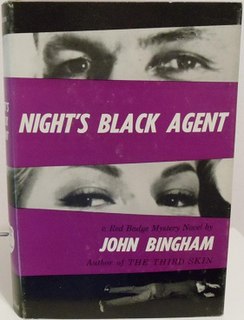
Night’s Black Agent is a 1961 thriller novel by the British writer John Bingham.
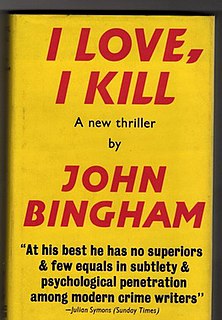
I Love, I Kill is a 1968 thriller novel by the British writer John Bingham. Dodd Mead released it in America with the alternative title Good Old Charlie.

The Double Agent is a 1966 spy thriller novel by the British writer John Bingham. It features the fictional head of British intelligence Ducane, who recurs in several of the author's novels. It was a runner-up for the Gold Dagger award.
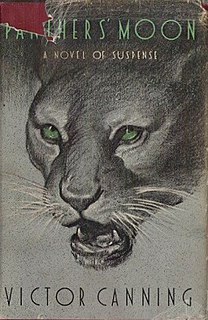
Panther's Moon is a 1948 spy thriller novel by the British writer Victor Canning. It was his second post-war novel, following The Chasm, as he had largely been taken a break from writing during his wartime service.

Dark Wanton is a 1948 thriller novel by the British writer Peter Cheyney. It was published in the United States under the alternative title Case of the Dark Wanton
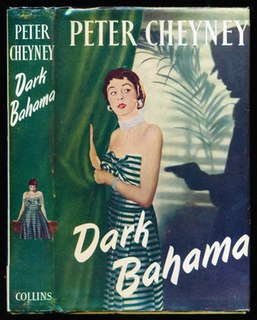
Dark Bahama is a 1950 thriller novel by the British writer Peter Cheyney. It was the second in a trilogy featuring the private detective Johnny Vallon, a hard-drinking former army officer. The story also features Quale, the head of British intelligence who appears on several other novels by Cheyney. Much of the action takes place in a fictional island in the Bahamas and nearby Miami in Florida.

Dark Duet is a 1942 spy thriller novel by the British writer Peter Cheyney. Cheyney had become known for his hardboiled crime thrillers featuring Lemmy Caution and Slim Callaghan, but this novel was his first fully-fledged espionage novel. The novel is set in wartime London, Lisbon and Ireland. It was published in the United States with the alternative title The Counterspy Murders.
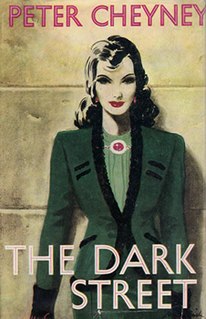
The Dark Street is a 1944 thriller novel by the British writer Peter Cheyney. It was published in the United States by Dodd, Mead with the alternative title of The Dark Street Murders. It follows on from both the 1942 novel Dark Duet and the 1943 novel The Stars Are Dark and features his recurring head of British counter intelligence Quale as well as the spy Shaun O'Mara. It begins in wartime occupied Paris before moving to London.

The Stars Are Dark is a 1943 spy thriller novel by the British writer Peter Cheyney. It was published in America with the alternative title The London Spy Murders. It follows on from the 1942 novel Dark Duet focusing on British counter intelligence operations during the Second World War, and introduces the character of Quale a senior British intelligence officer would appear in several novels.

Mysterious Mr. Sabin is a 1898 spy thriller novel by the British writer E. Phillips Oppenheim. It was the first spy novel by Oppenheim, a genre which he came to dominate during the First World War and interwar era. Revolving around a plot of a Frenchman selling British military secrets it became a bestseller, establishing him as a popular writer. It has been described as the novel "that launched Oppenheim's career of xenophobic espionage fantasy". It contains elements of invasion fiction, a common genre theme at the time.

The Second Man is a 1956 crime novel by the British writer Edward Grierson. It won the Gold Dagger award of the Crime Writers' Association.
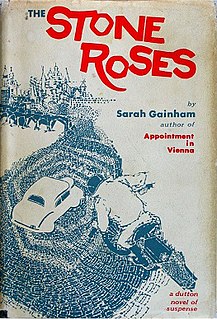
The Stone Roses is a 1959 spy thriller novel by the British writer Sarah Gainham. It is set in Prague shortly after the Communist coup in Czechoslovakia.

The Cold Dark Night is a 1957 spy thriller novel by the British writer Sarah Gainham. Her second novel, it is set at the height of the Cold War when the 1954 Berlin Conference saw the Big Four foreign ministers arrive in the divided city. Gainham had worked in Berlin as a journalist at the time of the Conference.

The Python Project is a 1967 spy thriller novel by the British Victor Canning. It is the third in a series of four novels about Rex Carver, a private detective drawn back into his old profession of espionage. A complex plot which involves a jewel robbery and the exchange of prisoners between the British and Soviet intelligence services takes place in a variety of locations including London, Paris, Libya and the Balearic Islands.

Firecrest is a 1971 spy thriller novel by the British writer Victor Canning. A stand-alone novel, it introduced a more modern, darker and naturalistic style compared to Canning's previous novels. It marked the first appearance of "The Department", a shadowy dirty tricks agency working for the British government which featured in subsequent novels.

Dead on the Track is a 1943 detective novel by John Rhode, the pen name of the British writer Cecil Street. It is the thirty seventh in his long-running series of novels featuring Lancelot Priestley, a Golden Age armchair detective. Like a number of mystery novels of the era, it has a railway setting. In theme and plot it is very similar to the author's earlier 1931 work Tragedy on the Line. It is the first entry in the series since Hendon's First Case (1935) in which Priestley's old associate Hanslet is the lead investigator. The other recurring police officer in the series Inspector Jimmy Waghorn is now working with military intelligence.
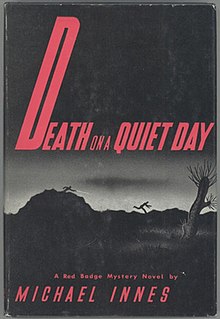
Appleby Plays Chicken is a 1957 detective novel by the British writer Michael Innes. It is the fourteenth novel in the long-running series by Innes featuring John Appleby, a senior detective with the Metropolitan Police. It blends the traditional Golden Age detective story with a mystery spy thriller plot. It was published in the United States under the alternative title Death on a Quiet Day.



















